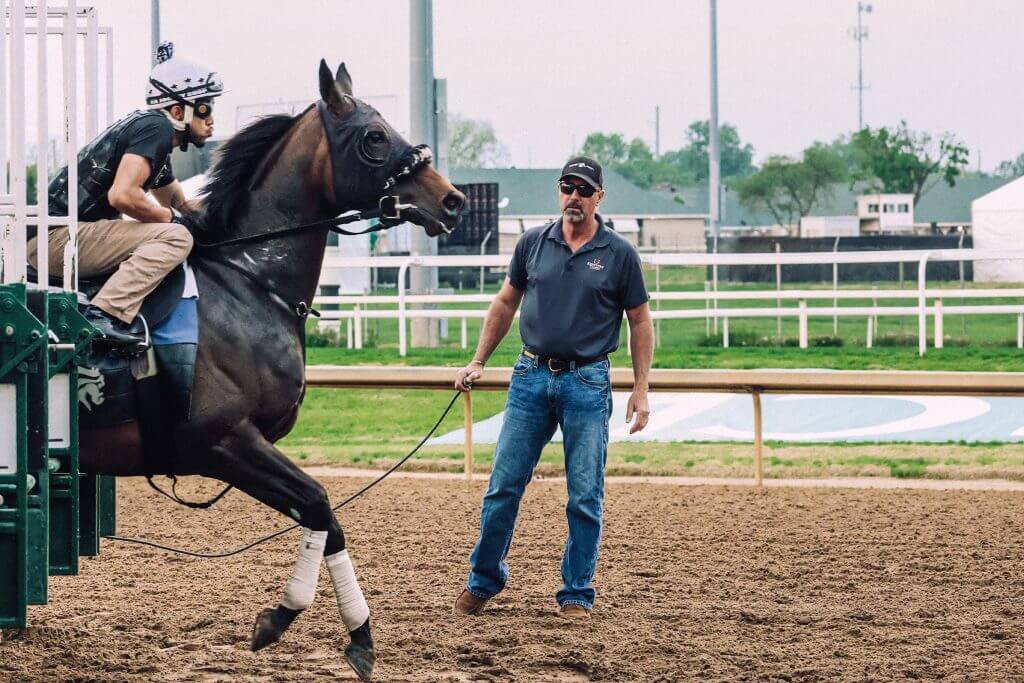
LOUISVILLE, Ky. — In the split second of silence between the last horse loading into the gates on the first Saturday of May and Churchill Downs track announcer Travis Stone yelling, “They’re off,” Scott Jordan stands atop a small metal perch on the track’s inside rail. Directly in his sightline, 20 jockeys sit astride 20 adrenaline-fueled thoroughbreds squished into a space that barely contains their girth, all waiting to break for a mad dash toward history.
Advertisement
At the same time, 160,000 people dressed in seersucker suits, feathered hats and finery, rise and hold their collective breath, joining millions more doing the same from their living rooms and Kentucky Derby parties across the country. Jordan, the track’s head starter, grabs a button in his right hand, the same sort of innocuous mechanism a Jeopardy contestant might use to buzz in.
When Jordan decides it is time, and only when Jordan decides, he presses the button to drop the gates and start the Kentucky Derby.
It’s 7 a.m. on a warm but cloudy Wednesday morning. Horse trainer Al Stall stands atop a wall of pavers just outside the rail near the third turn of the track. A few furlongs and what might as well be a world away, people stream around on the backside by the hundreds. Out-of-towners trail tour guides through the barns. Locals fill the viewing area, many with small children in tow, many dressed in their Catholic school uniforms, primed for a quick dash to beat the first bell after watching the Derby horses train.
But it is here — with Stall, Jordan, a small collection of workers and an ever-rotating line of horses quietly walking about — that some of the most important bits of the horse-racing business get done. Before they can finish the race, the horses need to start it, and in this small patch of dirt that serves as his weekday office, Jordan makes sure they can do so properly.
Starting a race is much more than pushing that button. Packing a 1,000-pound animal itching to race into a metal pen and asking it to wait for its release is as unnatural as it sounds.
That’s why during the days leading up to the Derby, every one of the entrants will frequent the six-horse starting gate tucked into the quarter chute just off the Churchill track to “school.” “Schooling” is a horse term for exactly what it sounds like — teaching the animals how to start correctly and safely.
Advertisement
“We’ve got that filly who wouldn’t load the other day coming,” Stall yells to Jordan. On cue, the still unnamed horse and rider approach. She is still not terribly interested in wedging herself into the gate. She turns sideways and stubbornly refuses to budge for the attendant trying to lead her in.
After a few futile attempts, Jordan grabs her lead and starts coaxing her in. It takes more than a few tries to determine the victor in this equine-versus-man battle. Eventually Jordan emerges triumphant, the filly settled into the gate where she stands for a handful of minutes to get used to her new surroundings. The misleadingly simple and incredibly important work is completed.
“Look around. You have [Bob] Baffert horses, Steve Asmussen,” Stall said, referring to the six-time Derby winner and winningest trainer in Churchill history, respectively. “You can’t not do this right. The game’s hard enough without messing up the start of the race.”
Jordan grew up in Ohio, where his dad trained horses. He longed to be a jockey, but genetics had other plans. He grew too tall and instead settled for galloping horses at Beulah Park in Columbus. The head starter there asked him if he wanted to help out working the gate in the afternoon, guiding the horses in for the starts. It was extra money, so he happily signed up. As often happens with life plans, a simple decision grew into a full-on pivot, and he wound up bouncing from Beulah to Belterra Park in Cincinnati and Turfway in Florence, Ky., to work the gates. People at Turfway knew a guy or two at Churchill, and in 1995, Jordan relocated to the famed Louisville track to man the gate.
In 2006, he became Churchill’s head starter, which meant that along with the countless other races there, he was put in charge of starting the single most famous event in horse racing. He appreciated the enormity of the gig and leaned on the late John Asher, the beloved vice president of communications, to help him navigate the new job.
Advertisement
Jordan knew horses well and understood that part of the job, but Asher helped him work the human angle. He’d bring Jordan along when he spoke to owners and trainers, helping his new starter to forge the sort of trusting relationships necessary to do his job well.
“That is probably a thankless job, and it’s really difficult,” Baffert said of Jordan. “But he’s a good horseman. With 20 horses, once you load that last horse in, you better be facing down the gate, ready to go, because they’re going.”

Scott Jordan, right, monitors a horse and jockey releasing from the gate. (Holly Smith)
That’s where the schooling comes in. Horses aren’t unaccustomed to starting gates, but Derby horses are only 3 years old; many have only raced a handful of times. Squeezing into the narrow confines, the clang of the metal doors closing and the nearness of their neighbors can be unsettling, if not downright dangerous.
In the ninth race at Churchill Downs on Thursday, jockey Junior Alvarado, who will ride Sovereignty in the Derby, fell off his horse, Caramel Chip, after it stumbled out of the gate. Alvarado is fine (Caramel Chip went on to finish second, though a jockey-less rider is automatically disqualified), but it showed how one bad step can easily be the difference between history and disaster.
To prepare as best he can, Jordan looks out for quirks and tendencies, and for animals that routinely struggle. The schooling is, frankly, as much to educate him as the horses. A fidgety horse not only is a risk for itself and its rider; it can affect all of the horses waiting to start. A year ago, Jordan spent extra time with Sierra Leone after the horse delayed the start for several minutes in the Blue Grass Stakes, his Derby prep race. Come Derby time, Sierra Leone broke well and wound up finishing second, by a nose, to Mystik Dan.
“They break clear, it’s a good feeling,” Baffert said. “But they break bad, it’s like, ‘We’re done. What a shame.’ It’s just two minutes of agony and you’re like, ‘S—. I should have been a farmer.”
On Wednesday morning, a Baffert 3-year-old positioned for Saturday’s Pat Day Mile came to school with assistant trainer Jimmy Barnes on hand to watch. Madaket Road has only raced five times and not since early March. The horse fought loading for a good few minutes while Jordan calmly shared instructions with one of his staff, telling him not to guide the horse but to let him turn himself around. As the struggle continued, Jordan took charge, combining the tough love of a few shoves to the horse’s hindquarters to get him straight with some soothing conversation.
Advertisement
“You’re looking at me now, aren’t you?” he said as he got Madaket Road square.
Barnes watched the whole thing, radioing the horse’s progress back to Barn 33, where Baffert is stationed. “He’s slowly learning,” Barnes said with a smile. “Once he’s in there, he’s good.” After the horse settled in, and stood for a while, Jordan finally backed him out. Madaket Road and his rider sauntered off with Barnes. “Thank you guys,” Barnes called over his shoulder.
The real challenge for the Derby is its scope. For starters, a potential 20-horse field is uncommonly big and in 2020, Churchill created a new starting gate to house them. The gate stretches 65 feet and while the interior of the stalls is an inch-and-a-half wider than the typical gate, the divider between the stalls is slimmer.
Because of the expanded field, Jordan doubles the size of his staff for the Derby, stationing an extra two bodies as rovers to be on call if something goes wrong. Jordan will call for help if he thinks a horse needs soothing.
“I might call out, ‘Go to the six horse, pick up his tail and see how he does,’” Jordan said. “If he doesn’t like it, drop it. We have a plan.”
The bigger “big” issue, if you will, is the one thing Jordan cannot school the animals on — the 160,000 people who rise to their feet when the horses begin to load.
It is unlike any race the horses have run in, or will run in again. It also adds to the enormity of the job with which Jordan is tasked.
“You try to play it like it’s just another race,” Jordan said. “I keep telling myself that, but it’s not. You’re looking out across 20 of them, and you’ve got 160,000 people in the stands and millions of people watching. You just want everything to go right.”
(Top photo: Holly Smith)
This news was originally published on this post .







Be the first to leave a comment